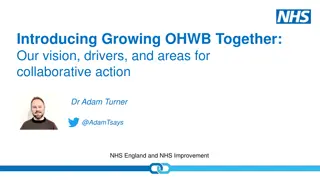Improving Wellbeing for NHS Staff: A Case for Health and Happiness
The presentation highlights the importance of prioritizing the health and wellbeing of NHS staff for better patient outcomes. It discusses the link between staff burnout, patient safety, and neglect, emphasizing the need for improved support systems. The financial implications of poor mental health are also addressed, along with the risks faced by doctors and nurses. Strategies for enhancing workforce wellbeing, including productivity, satisfaction, and reducing absenteeism, are explored to make the NHS a top workplace.
Download Presentation

Please find below an Image/Link to download the presentation.
The content on the website is provided AS IS for your information and personal use only. It may not be sold, licensed, or shared on other websites without obtaining consent from the author. Download presentation by click this link. If you encounter any issues during the download, it is possible that the publisher has removed the file from their server.
E N D
Presentation Transcript
MAKING A CASE FOR HEALTH AND WELLBEING Presenter(s)
THE NATIONAL LANDSCAPE Making the NHS the best place to work The Interim NHS People Plan contains a national ambition to make the NHS the best place to work. There is clear consensus across the health service that our workforce face a range of issues which affect their staff experience and ability to deliver quality care. Locally, we need to take action to best support the wellbeing of our staff.
A HEALTHY AND HAPPY WORKFORCE = BETTER PATIENT OUTCOMES Healthier staff Better staff engagement Happier and healthier patients
PATIENT EXPERIENCE PATIENT SAFETY PATIENT NEGLECT Clear association between staff burnout and patient safety. Trust-led health and wellbeing schemes including Schwartz rounds improve patient experience. Lessons learnt from the Francis Inquiry showed fatal impact of poor staff mental wellbeing.
IMPROVED WELLBEING LEADS TO A BETTER FUNCTIONING WORKFORCE 1. Productivity 2. Satisfaction 3. Absenteeism 4. Presenteeism 5. Turnover and retention 1 in 3 NHS staff have felt unwell due to work-related stress. 51% of line managers feel comfortable talking generally in the workplace about mental health issues.
NHS WORKFORCE IS AT RISK OF POOR WELLBEING, INCLUDING: DOCTORS Risk of suicide especially high among doctors. Doctors are unlikely to disclose poor mental wellbeing. Rates of depression among graduate doctors estimated at about 30%. NURSES Nurses are an at-risk group for unhealthy lifestyle behaviours. The impact of shift-working on nurse s health and wellbeing is evident.
2.4 BILLION 1,794 - 2,174 Cost of poor mental health Annual cost of sickness absence 4.20 80% + Return on investment in workplace mental health interventions for every 1 spent Of NHS staff believe health and wellbeing impacts on patient care
OUR STRATEGY A tagline or phrase to sum up your strategy / approach Text to outline your health and wellbeing strategy for the trust and explain how it will enable staff and patient outcomes. Be clear in what you plan to achieve, successes and impact so far. Discuss your next steps and areas of priority. Explain how your board can support you to deliver your strategy. Limit your information to high level succinct bullet points to summarise key messages your leaders need to know.


























